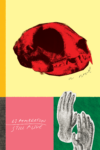This essay first appeared in the Full Stop Quarterly, Issue #5.
In February of 1768, a largely self-educated Parisian craftsman presented an ambitious proposal to the French Academy. Contrary to the long tradition of trade secrets controlled by guilds, André Jacob Roubo proposed to publish a treatise on woodworking so detailed it verged on the absurd. He wanted to record for the world the techniques and knowledge of the workmen of the Parisian ateliers. The Academy accepted his proposal as a part of their ongoing efforts to describe the state of the arts in the encyclopedic mode of the French Enlightenment. Called L’art du menuisier, Roubo’s book was published in several volumes beginning in 1769. It ran to thirteen hundred pages, with 382 detailed plate engravings depicting tools, furniture, and the details and geometry of architectural forms.
Yet because of his background as a craftsman, the book was more than simply a description—Roubo imagined it as being useful to practitioners of the craft, and so made it as exhaustive and self-sufficient as possible. He focused on the techniques of the old masters, carefully recording their wisdom and traditions so that he could keep such knowledge alive. Ironically, this very virtue also increased the investment of time and money required of the book’s readers and users. This put it at a disadvantage compared with less complete, but slimmer and cheaper books. He was writing, it turned out, not so much for the skilled laborers in the workshops of France, but for “the well-off and industrious citizen” looking for projects and skills “all the more useful as it exercises the body and the mind.” In doing so, Roubo defined the scholarly end of trade publications, a blue-collar staple of the printing and writing industries down to the present.[1]
Now, nearly 250 years later, it’s being published again in a new, edited, single-volume translation called With All the Precision Possible: Roubo on Furniture Making. This time, instead of the resources of Louis XV’s state, twelve years of work by the tiny independent publisher Lost Art Press (located mostly in Covington, KY) have brought this text into the world. It is, like all Lost Art Press books, a beautiful object in itself: large, lushly illustrated with the original plates, and annotated by modern day woodworkers. It has a sewn cloth binding, archival quality paper, and painted edges to the pages. For this project, the translators and editors Don Williams, Michele Pietryka-Pagan, Philippe Lafargue, and editor Christopher Schwarz have selected the sections of the original they deemed of most use for modern woodworkers. The translation captures the eighteenth-century flavor of Roubo’s prose, but with bracketed explanations when the precise translation of the French has a more generally accepted technical term in the modern American woodworker’s parlance (the pins and tails of a dovetail joint, for instance). Mixed in with this translation, the editors have included original essays for a modern audience where explanations of how to make and use some of the tools and pieces of furniture he describes are required.
Inherent in the return to this project is a return to its contradictions. A harmonic overtone of nostalgia colors the aesthetic of Lost Art Press and the hand tool woodworking subculture it helps define and propel. It’s a sort of authenticity-based affect that carries blue-collar credibility. The woodworker has long had a special place in the anti-modern mythology of popular culture—especially for men. I’d be willing to bet that Nick Offerman, recent author of a woodworking book of his own, is among the first round of purchasers for the Roubo book and the rest of Lost Art Press’s catalogue. But just like Roubo, Lost Art Press isn’t aiming its projects as much for production workers as it is for relatively affluent basement and garage hobbyists drawn to “the simple life” and the traditional arts, and taking their DIY game to the next level. Lost Art Press’s mostly daily blog features several authors and other contributions, a technically brilliant Instagram account documents Schwarz’s projects, and the press makes the rounds of hand tool events (yes, such things happen all over the world). Other publications, like Mortise & Tenon magazine have sprung up in new niches created by the trend. Several Instagram celebrities (such as Anne of All Trades, with close to sixty thousand followers) set the pace with feeds featuring a mix of antique tools, barnyard animals, and furniture projects. Hobbyist woodworkers all over the world share photographs of projects in real time, crafting an image of their work as beautiful and fulfilling, with hashtags like #woodshavingwednesday or #handtoolthursday.
But this past-focused woodworking community seems mostly unaware of a paradox at its center. The social network-based democratization of Instagram and blogs created a virtual space for community to form around this nostalgia. The very infrastructure upon which the supposedly independent community is built relies on surveillance and monetization of users by massive capitalized corporations. The ethos is vaguely Jeffersonian, yet most of the posts feel wholesomely apolitical, only trying to bring what was appealing about the past into the current moment and updating it to modern (and modernist) sensibilities. Perhaps for that reason, apoliticism seems to be what Lost Art Press is most insistent that hand tool woodworking is not.
•
The catalogue of Lost Art Press has grown to twenty-five books, as well as a handful of instructional videos. These include other re-edited reprints along the lines of Roubo on Furniture, but the foundations are the books of Christopher Schwarz, a co-founder of Lost Art Press. His first Lost Art Press book is The Anarchist’s Tool Chest (2011), which tells the story of Schwarz’s evolution from a tool consumer to a craftsman with a modest set of essential tools. He explains each of those tools, where to find good ones (antique stores and estate sales are a good bet), how to fix up old tools, and how to build a traditional joiner’s tool chest. Schwarz tells the story with a blend of self-deprecating barroom humor and indefatigable scholarly intensity. He delights in tracking down anecdotes and texts from the history of the craft. He always takes the facts, but not himself, seriously.
His apprenticeship as a writer and editor bears fruit in functional, useful sentences laced with a sarcastic cheer much like that he brings to his woodworking when he makes three legged back stools. It’s the same blend of human story, goofy jokes, and traditional craft knowledge that anchors Roy Underhill’s ongoing PBS show, “The Woodwright’s Shop,” where Underhill has a persona as a sort of manic Julia Childs/Bob Ross of woodworking. And that’s no coincidence. The Anarchist’s Tool Chest is dedicated to Underhill, and Schwarz has appeared on the show multiple times.
Both Underhill and Schwartz come at woodworking from a perspective that goes beyond the usual technical detail. To them craft is a moral issue, even a political issue. Doing good work means doing your homework, understanding the broader context, and not taking lazy or dishonest short cuts. That sort of craftsman morality underpins the appeals to “blue collar honesty.” Call that the “conservative” half of the formula, if you want—it is focused on the individual and their choices. On the other side, though, Schwarz also recognizes the predicament of the consumer. By buying cheap goods that are mass manufactured (and are often supported by the structure of the marketplace—itself controlled not by the workers but by owners and investors) we are almost forced to participate in and perpetuate exploitation and degradation. This makes buying cheaply made furniture—even if it’s the modish sort you can find at hip places like West Elm—shortsighted, stupid, and morally wrong. But also unavoidable unless you build your own. Such a claim has a long history. The argument would be familiar to John Ruskin, William Morris, or Henry David Thoreau. But also to Karl Marx and Peter Kropotkin.
So with such a radical pedigree, and provocative title, perhaps it’s no surprise that a larger established company wouldn’t take on the project. Part of the story of The Anarchist’s Tool Chest is that Schwarz had to start his own press in order to write and publish his book. Before founding the press, he was the editor of Popular Woodworking magazine, which for those who haven’t read one, is something like what Good Housekeeping would be if sold at the checkout lines of Home Depot instead of Target (full disclosure, I am an avid reader of “pop wood” and have a short article forthcoming in their pages). Popular Woodworking wouldn’t touch anything labeled anarchist.
But on publication, The Anarchist’s Tool Chest was a sleeper hit. It breaks all the rules for a book—it’s politically radical yet aimed at what would seem to be a conservative leaning audience. It costs almost fifty dollars. It is made entirely in the United States. It’s full of expensive photographs and illustrations. It isn’t distributed to bookstores or available on Amazon. There is none of the standard publicity.
And all of this practices the anarchist principles laid out in the book. It isn’t about wearing black, tagging your neighborhood with As, and adding lots of safety pins to your clothes and body. Neither does Schwarz call for rioting or violence or dumpster diving (which may all have their place). Instead, what Schwarz calls “aesthetic anarchism” is centered on skepticism that the benefits of rationalization and centralization outweigh the costs, or that efficiency and growth are absolute values. He calls back a political tradition that insists on the right of producers to own their own tools, sell directly to the customer, and create a product that answers to the internal quality standards of a craft, not the uninformed consumer desires of the marketplace. In this model, community, tradition, and affection guide a craftsperson’s choices, not bureaucratic regulations or the coercion of “the market.”
Schwartz’s second anarchist book, The Anarchist’s Design Book, goes beyond a historically based stable of tools and how to store them to focus on the basic forms of vernacular European furniture that have been largely unchanged since the Middle Ages. On one level, sure, that’s fairly apolitical: There have been plenty of regime changes since the twelfth century. On the other hand, the book is built on the argument that vernacular furniture—do it yourself in the most robust sense—is less and less available to the masses. This isn’t so much a problem of skill, but one of imagination. Schwarz points out that we’ve been led to believe that making or repairing furniture (or anything) requires a huge investment in time, skill, tools, and material. We have been trained to be docile consumers who fill up landfills.
Of course, historically, most people weren’t able to make the investment required to make or fix high-end furniture—the sort of antiques that get sold at auction. One result was they owned a lot less stuff than we do now. Another was that more of the stuff they owned was homemade.
The book explains, again in narrative form, how to make that kind of simple furniture. With more or less the same basic set of flea market tools in the Anarchist’s Tool Chest, along with a willingness to try, experiment, fail, and try again, Schwarz shows that most people can turn out simple, functional furniture. And it will be better made than what is available flat packed from local box stores, and at a fraction of the price of antiques or what handmade furniture costs. Since crafts people have to make a living building something like a chair a week, if they are quick, that sort of production will never be democratically available. It is cost prohibitive for all but the wealthy, and always will be. (This critique, also leveled at William Morris’s Arts and Crafts movement—that the laborers were making furniture for the rich and thus failing at the Marxist goal of revolution—has never struck me as very damning. There has to be some mechanism to get money from where the money currently is, and we ought to be forgiven if we prefer this one to violence.)
The larger political argument in these “anarchist” books is that in a society structured by late consumer capitalism, we’ve all sold our birthright to making things for the bowl of pottage that is IKEA bookshelves and meaninglessness. It’s an appealing argument for direct action, not just in politics, but in daily material life.
•
The surprise success of Schwartz’s books prompts some questions: What conditions is Lost Art Press responding to? And why has this response been so successful?
The conditions, obviously, are the same ones that suffuse our political moment. Sit down to actually read Karl Marx and it will be difficult not to grant that his analysis of the conditions of capitalism, if not his rather nebulous prescriptions, are prescient. His labor theory of value is appealing, especially to those who have skill in making things. The concentration of capital, high barriers to entry, and economies of scale with diminishing returns all work against the “petite bourgeois” craftsman. As Yale professor James C. Scott points out in Two Cheers for Anarchism, “the petite bourgeoisie and small property in general represent a precious zone of autonomy and freedom in state systems increasingly dominated by large public and private bureaucracies.” The recent bestseller status of Thomas Piketty’s Capital in the Twenty-first Century is an expression of dissatisfaction with the current system, and a desire to understand and resist it. And, if we are generous, we might also attribute the rise of our current president as symptomatic of many of the same social and economic frustrations.
So, it seems a large group of people feels left behind; especially of those in the classes that once had the fabled “good manufacturing jobs.” These are what Hannah Arendt called “the mass.” Our experience in the world of the masses includes navigating many structures that feel ahistorical and impersonal—for example, the furniture market as consumer, and the job market as potential producers. As Matthew Crawford pointed out in another bestseller, Shopclass as Soulcraft, much of the work in an “information economy” feels largely disconnected from any self-evident internal standards of quality. It’s hard to link any given memo written or form completed to the desired outcome that is professed. In fact, a whole class of “consultants” and a genre of self-actualization self-help books (a genre the Lost Art Press books might be shoehorned into) tries to fill that need.
Historically, the masses are the “refuse” of the tradesmen and craftswomen along with the small farm families that made up the bulk of the US economy prior to the twentieth century, and a fairly well established class with interests: the petite bourgeoisie. They often lived on the edge of economic disaster, and were acutely aware of the crushing power of market forces—that’s one reason that the Republican Party was a labor party when it was founded before the Civil War. When the Republican Party transformed into the party of capital after the Civil War, the labor issues of the petite bourgeois were taken up by the Populists and the Nonpartisan League. These third parties, like most labor movements, relied on a utopian view of tradition—one full of pastoral imagery of bountiful and bucolic rural retreats, where the worker enjoys economic self-determination. So “freedom” became associated with the sights and sounds of the village carpenter’s workshop and the small family farm.
The critique of this claim to autonomy and self-determination with the most bite is a standard one for all forms of libertarianism: Those with the means to follow this path are themselves probably winners in the current system who have the means to make some lifestyle tweaks. As an ideology it boils down to doing what you want while downplaying both luck and what you were given. Many of the highest profile Instagram woodworkers fit that bill and seem to have retired young after lucrative careers. Other standouts are, by definition, exceptions who work extraordinarily hard and well—that’s why they stand out. And finally, such criticism will never stop the appeal of the success story—this is the dream, after all. Such deep roots are not easy to kill. And besides, trying to close off access to that dream can itself lead to undesirable and exclusionary outcomes.
But it’s the turn to tradition and history that sets the hand toolers apart. This sort of novel traditionalism can’t rightly be called conservative: It’s not seeking to maintain the current structures of power in the least. But it’s also suspicious of innovation and even the nature of progress—so “progressive” is a pretty inadequate label. Liberal, in the old Roman sense of “not enslaved,” might work, but that’s just not what the word means these days. Instead, the hand tool woodworking books of Lost Art Press have settled on anarchist, sometimes with the addition of “aesthetic.” And that’s great. It’s also telling that it’s historically accurate. Because really at the root of this press (and in the name) is a certain stance toward the past: They want to recover what has been lost. And in doing so, they select and present a certain thread from the past, and try to make it legible in the present.
That’s why they republished Roubo. It’s also why they published a four-volume folio of articles from the post-war English magazine The Woodworker. The editor, Charles Hayward, had the same conservationist project as Roubo two centuries earlier, and as Lost Art Press a hundred years after that. Hayward had been trained in the post-Victorian era when the British Empire was at its peak, and the craft economy had declined, just as Marx predicted. Reading through the magazine begins to show how far craft has fallen in esteem in the consumer era.
Valuing the past is also why Lost Art Press is putting out a letterpress edition of a book that’s a sort of method archeology—it’s on Roman workbenches built from frescos and tested by Schwarz. They have a book on the robust “campaign furniture” of the pre-industrial British military. Respect for the past, with a healthy dose of personal experiment and “take it or leave it” bravado to moderate the worst effects of nostalgia, finally drives most of what’s going on at Lost Art Press.
And that wish to recapture something that’s lost, to find the hues gone missing since whatever Golden age, is not the provenance of one political party. The hipsters with their PBR aesthetic and the Trumpies with their hats and retrogression have this in common. Perhaps our best hope for the future—ecological as well as economic and political—is that we can foster more anarchy of this sort. Enlightenment didn’t come easy in Roubo’s France, nor did it end particularly well. But, for those willing to take tradition into our own hands, perhaps we can give it life again.
[1]See Belhoste, Bruno. “A Parisian Craftsman Among the Savants: The Joiner André-Jacob Roubo (1739–1791) and his Works.” Annals of Science 69, no. 3 (July 2012): 395–411.
Daniel D. Clausen is an amateur woodworker and literature PhD candidate at the University of Nebraska. His work and reviews have appeared in Western American Literature, Interdisciplinary Studies in Literature and the Environment, and The New Territory.
This post may contain affiliate links.








